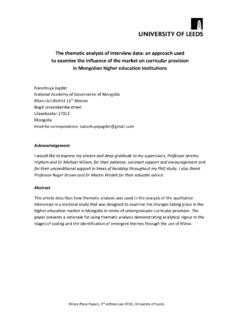Transcription of Power factor correction: A guide for the plant ... - Eaton
1 Effective November 2020 Capacitor banks Technical Data SA02607001E Supersedes August 2014 and harmonic filters Power factor correction : a guide for the plant engineer Contents Description Page Description Page Part one: Power factor Part two: Harmonics What is Power factor ?.. 2 Introduction.. 17. Should I be concerned about What are harmonics? .. 17. low Power factor ?.. 3 What are the consequences of high What can I do to improve Power factor ?.. 3 harmonic distortion levels? .. 18. How much can I save by installing IEEE 519 .. 18. Power capacitors?.. 4 How are harmonics generated? .. 19. How can I select the right capacitors What is the relationship between Power factor for my specific application needs? .. 8 correction capacitors and harmonics?.. 19. How much kVAR do I need?.. 8 How do I diagnose a potential Where should I install capacitors harmonics-related problem?
2 20. in my plant distribution system?.. 14 What is an active harmonic filter?.. 20. Can you use capacitors in nonlinear, How can you eliminate harmonic problems? .. 20. nonsinusoidal environments? .. 16. What is a passive harmonic filter? .. 20. What about maintenance? .. 16. Do I need to perform a system analysis to correctly apply harmonic filters?.. 21. What is Eaton 's experience in harmonic filtering?.. 21. Useful capacitor formulas.. 22. Power factor correction capacitor bank survey sheet .. 23. Technical Data SA02607001E Power factor correction : . Effective November 2020 a guide for the plant engineer .. Part one: Power factor What is Power factor ? Special electrical requirement of inductive loads Fundamentals of Power factor Most loads in modern electrical distribution systems are inductive . Power factor is the ratio of working Power to apparent Power .
3 Examples include motors, transformers, gaseous tube lighting It measures how effectively electrical Power is being used. A high ballasts and induction furnaces. inductive loads need a magnetic Power factor signals efficient utilization of electrical Power , while field to operate. a low Power factor indicates poor utilization of electrical Power . inductive loads require two kinds of current: To determine Power factor (PF), divide working Power (kW) by apparent Power (kVA). In a linear or sinusoidal system, the result Working Power (kW) to perform the actual work of creating heat, is also referred to as the cosine . light, motion, machine output and so on . Reactive Power (kVAR) to sustain the magnetic field PF = kW = cosine . Working Power consumes watts and can be read on a wattmeter. kVA. It is measured in kilowatts (kW). Reactive Power doesn't perform For example, if you had a boring mill that was operating at 100 kW.
4 Useful work, but circulates between the generator and the load. and the apparent Power consumed was 125 kVA, you would divide It places a heavier drain on the Power source, as well as on the 100 by 125 and come up with a Power factor of Power source's distribution system. Reactive Power is measured in kilovolt-amperes-reactive (kVAR). (kW) 100 = (PF ) Working Power and reactive Power together make up apparent (kVA) 125. Power . Apparent Power is measured in kilovolt-amperes (kVA). Note: For a discussion on Power factor in nonlinear, nonsinusoidal systems, turn to Page 16. Heat component =. work done G. Circulating component =. no work Figure 3. kVA Power Resistive G load Light kVA. Hot plate kW- = PF. COS = ---------- kVAR. kVA. Figure 1. kW Power . kW. M. Motor Figure 4. Power triangle G field Note: A right Power triangle is often used to illustrate the relationship between kW, kVAR and kVA.
5 Figure 2. kVAR Power 2 Eaton Power factor correction : Technical Data SA02607001E. a guide for the plant engineer Effective November 2020.. Should I be concerned about What can I do to improve Power factor ? low Power factor ? You can improve Power factor by adding Power factor Yes, because low Power factor means you're not fully correction capacitors to your plant distribution system. utilizing the electrical Power you're paying for. When apparent Power (kVA) is greater than working Power (kW), As the triangle relationships in Figure 5 demonstrate, kVA decreases the utility must supply the excess reactive current plus the as Power factor increases. At 70% Power factor , it requires 142 kVA working current. Power capacitors act as reactive current generators to produce 100 kW. At 95% Power factor , it requires only 105 kVA (see Figure 6). By providing the reactive current, they reduce the to produce 100 kW.
6 Another way to look at it is that at 70% Power total amount of current your system must draw from the utility. factor , it takes 35% more current to do the same work. 95% Power factor provides maximum benefit Theoretically, capacitors could provide 100% of needed reactive Power . In practical usage, however, Power factor correction to approximately 95% provides maximum benefit. The Power triangle in Figure 7 shows apparent Power demands on a system before and after adding capacitors. By installing Power capacitors and increasing Power factor to 95%, apparent Power 142 is reduced from 142 kVA to 105 kVA a reduction of 35%. kVA. 100. kVAR. 18 A M. 100 kW. 100 10 hp, 480 V motor PF = -------- = 70% at 84% Power factor 142. 16 A M. 105. kVA. 33. kVAR A.. 100 kW. 100. PF = -------- = 95% 3 kVAR. 105. Capacitor Power factor improved to 95%. line current reduced to 11%.
7 Figure 5. Typical Power triangles Note: Current into motor does not change. Figure 6. Capacitors as kVAR generators COS 1 = 100. ---------- = 70% PF. 142. COS 2 = 100. ---------- = 95% PF. 105 67 kVAR. re capacitor fo added be 70% PF. A 100 kVAR. kV before before 4 2. 1. a fter k VA. 105 33 kVAR. 1 95% PF. after 2 after Figure 7. Required apparent Power before and after adding capacitors Eaton 3. Technical Data SA02607001E Power factor correction : . Effective November 2020 a guide for the plant engineer .. How much can I save by installing Power capacitors? Case 2. Power capacitors provide many benefits: Assume the same conditions except that: 400 kW @ 87% = 460 kVA. Reduced electric utility bills 400 kW @ 97% = 412 kVA corrected billing Increased system capacity kVA demand charge: Improved voltage Reduced losses $ / kVA / month (112,400 kWh / month energy consumed).
8 Reduced utility bills Energy charge: Your electric utility provides working (kW) and reactive Power (kVAR) $ / kWh (first 200 kWh / kVA of demand). to your plant in the form of apparent Power (kVA). While reactive $ / kWh (next 300 kWh / kVA of demand). Power (kVAR) doesn't register on kW demand or kW hour meters, $ / kWh (all over 500 kWh / kVA of demand). the utility's transmission and distribution system must be large Uncorrected: enough to provide the total Power . Utilities have various ways of passing the expense of larger generators, transformers, cables 460 kVA $ = $ and switches along to you. $ $ savings in demand charge As shown in the following case histories, capacitors can save you money no matter how your utility provider bills you for Power . Corrected: kVA billing 412 kVA $ = $ The utility provider measures and bills every ampere of current, Uncorrected energy: including reactive current.
9 KWh = 112,400. 460 200 = 92,000 kWh Case 1 @ = $ Assume an uncorrected 460 kVA demand, 480 V, three-phase 460 300 = 138,000. at Power factor (normally good). but balance only = 20,400. @ $ = $ Billing: $ demand $ Correct to Power factor +$ $ uncorrected energy charge Solution: Corrected energy: kVA Power factor = kW. 460 = 400 kW actual demand kWh = 112,400. 460 200 = 82,400 kWh kW = kVA @ = $ PF. 460 300 = 123,600. 400 = 412 corrected billing demand but balance only = 30,000. @ $ = $ From Table 6 kW multipliers, to raise the Power factor from $ to requires capacitor: +$ $ corrected energy charge Multiplier of x kW. x 400 = 126 kVAR (use 140 kVAR) $ $ Uncorrected original billing: $ savings in energy charge due to rate charge 460 kVA $ = $2185 / month (9600 kWh in first step reduced by $ ). $1957. $ 228 / month savings 12 This is not a reduction in energy consumed, but in billing only.
10 $2736 annual savings $ energy $ demand Corrected new billing: $ monthly total savings 12. 412 kVA $ = $1957/month $ 140 kVAR, 480 V capacitor cost: $1600 (installation extra). A 130 kVAR capacitor can be paid for in less than 14 months. This capacitor pays for itself in less than eight months. 4 Eaton Power factor correction : Technical Data SA02607001E. a guide for the plant engineer Effective November 2020.. kW demand billing with Power factor adjustment The utility charges according to the kW demand and adds a Case 2. surcharge or adjustment for Power factor . The adjustment may be a multiplier applied to kW demand. The following formula With the same 400 kW load, the Power factor is only 81%. shows a billing based on 90% Power factor : In this example, the customer will pay an adjustment on: 400 = 444 billing kW demand kW demand actual Power factor (From Case 1: When the Power factor = 96%, the billing demand If Power factor was , the utility would require 7% increase is 375 kW = $ per month.)















